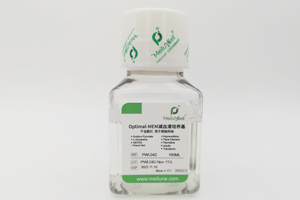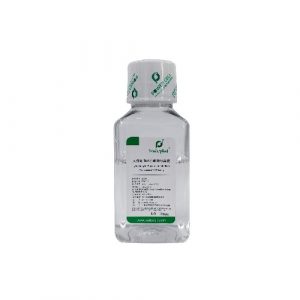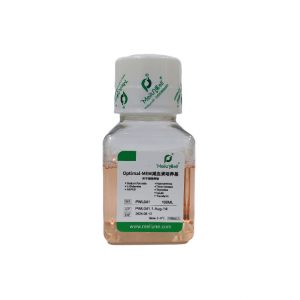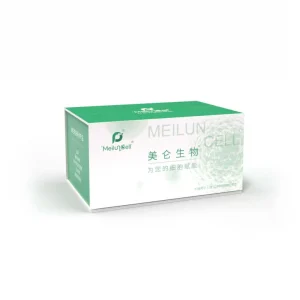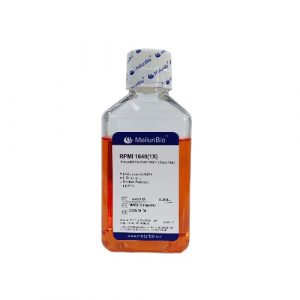Product Description
Optimal MEM Reduced Serum Medium is a modified reduced serum medium based on Minimal Essential Medium (MEM), which is capable of a variety of suspended and adherent mammalian cells, including Sp2/0, AE-1, CHO-K1, BHK-21, 293T, Vero, etc., with a reduction of Fetal Bovine Serum supplementation by at least 50%. Optimal MEM reduced serum medium is designed for cell transfection and is recommended to be used in conjunction with the Cationic Liposome Transfection Reagent (MA0672).
This product contains: L-glutamine, HEPES, phenol red, sodium pyruvate, insulin, transferrin, hypoxanthine, thymidine and trace elements.
Production process: This product is prepared by using Water-For-Injection (WFI), and the production procedure is strictly in accordance with the cGMP management regulations, and is completed in the clean room for the record of in vitro diagnostic reagents. The company has obtained ISO9001 quality system certification.
Product Advantage
- Used in conjunction with cationic liposome transfection reagents, it can effectively improve the transfection efficiency.
- Effectively increase the cell proliferation rate under reduced serum culture without affecting the viability and morphology.
- It can reduce the amount of serum added, which helps to reduce the fluctuation of culture conditions and prolong the use time of the same batch of serum.
- The water for injection is configured in accordance with GMP regulations for production, stable process and small batch variation.
- Raw materials are selected from self-production or after strict testing, selecting purified low endotoxin high-purity pharmaceutical grade raw materials, low pyrogen level, reducing exogenous endotoxin interference.
- Strict quality testing procedures, much higher than the industry’s required indicators, outstanding product performance, indicators comparable to international.
- Imported material aseptic packaging bottles, in line with GMP management regulations, excellent airtightness and internal coating protection, greatly ensuring the stability of the product.
Product packaging form:
PWL042-1: 100mL per bottle;
PWL042-2: 500mL per bottle, 20 bottles per case (of which the whole case is packed, with protective foam pads in cardboard boxes to ensure transportation safety).
Performance
1. Cell proliferation assay
Method: In the presence of 2% FBS, Meiluncell Optimal-MEM and company G Opti-MEM were used to culture 293T, BHK-21, CHO-K1, Sp2/0-Ag14, Vero, AE-1 with appropriate cell population. Cell counting and survival rate detection were performed 72 hours later.
Results: The cells cultured using Meiluncell Optimal-MEM proliferated more cells, the survival rate was similar to that of the control and even higher than that of the control in some cells, and the cell growth status was good.
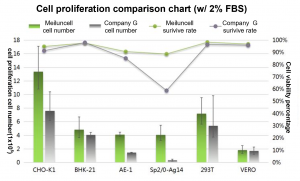
Figure 1: Comparison of cell number and viability of different cells in Optimal-MEM culture
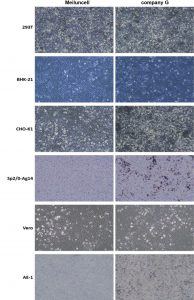
Figure 2: Comparison of different cell growth states in Optimal-MEM culture
2. Cell adherent rate assay
Methods: BHK-21 and CHO-K1 cells inoculated with 100 cell counts were cultured using Meiluncell Optimal-MEM and G brand Opti-MEM, respectively, under the condition of containing 5% FBS, and staining and counting were performed after the appearance of obvious cell clustering.
Results: As shown in the figure, the cells cultured with Meiluncell Optimal-MEM had a higher adherent rate.
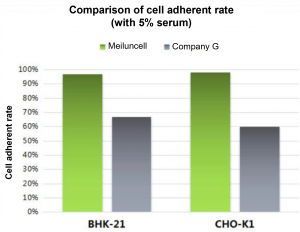
Figure 3: Comparison of different cell adherention rates in Optimal-MEM culture
3. Adherent cell transfection efficiency detection
Methods: Plasmids (expressing EGFP) were transfected on 293T, BHK-21, CHO-K1, and Vero respectively, and Meiluncell Optimal-MEM and company G Opti-MEM were used as transfection media. The transfection efficiency was observed with a fluorescence microscope 72 h after transfection.
Results: The number of cells transfected using Meiluncell Optimal-MEM as the transfection medium was significantly more than that of ordinary MEM, which was similar to the company G control.
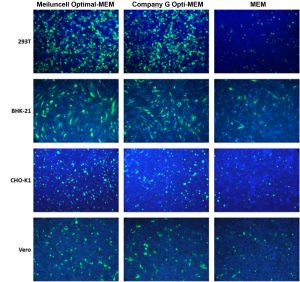
Figure 4: Comparison of cell transfection efficiency when Optimal-MEM was used as transfection medium
4. Suspension cell transfection efficiency detection
Methods: EGFP plasmids were transfected on Expi 293F and CHO-K1 GS respectively. Meiluncell Optimal-MEM and company G Opti-MEM were used as transfection media respectively. The transfection efficiency was observed with a fluorescence microscope 72 hours after transfection.
Results: As shown in Figure 5, the number of green fluorescence of Expi 293F cells transfected using Meiluncell Optimal-MEM was similar to that of the company G control; as shown in Figure 6, the fluorescence intensity of CHO-K1 GS using Meiluncell Optimal-MEM is similar to that of company G.
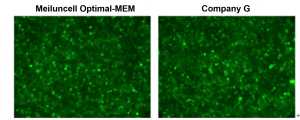
Figure 5: Comparison of transfection efficiency of Expi 293F cells using Optimal-MEM as transfection medium
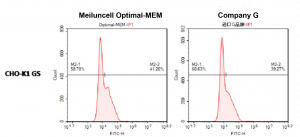
Figure 6: Comparison of transfection efficiency of CHO-K1 GS cells using Optimal-MEM as transfection medium
5. Virus packaging efficiency detection
Method: Retrovirus (expressing EGFP) was packaged on 293T, and Meiluncell Optimal-MEM and company G Opti-MEM were used as transfection media respectively. The virus fluid was harvested 72 hours after transfection and then infected with 293T. After 48 hours, the expression of green fluorescent protein was detected by flow cytometry.
Results: After infecting cells, the retrovirus packaged using Meiluncell Optimal-MEM had a green fluorescent protein expression rate similar to that of the company G control (±10%), indicating that the titers of the viruses packaged by the two were similar.
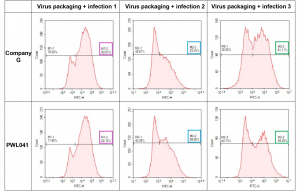
Figure 7: Comparison of retrovirus packaging efficiency when Optimal-MEM is used as transfection medium
Shipping and Storage
- Storage:Store at 2-8°C away from light, effective for 12 months.
- Shipment:Room temperature
Usage Statement
Research Use Only (RUO)
All sales are subject to the General Terms and Conditions of Sale set forth on our website.

